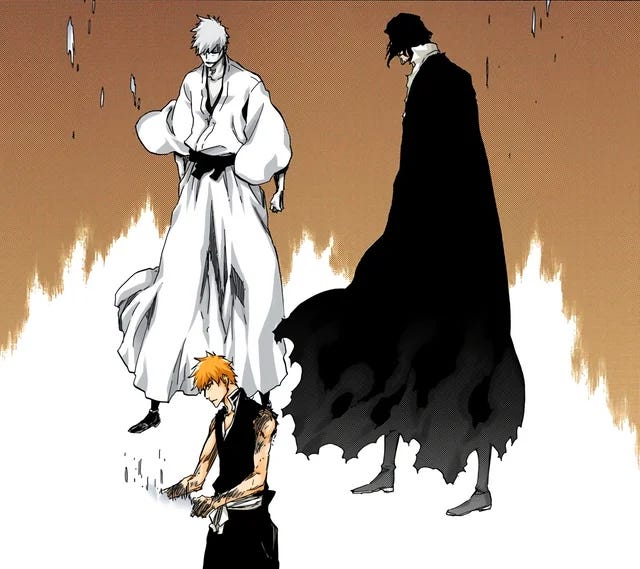A recurring trope in many shonen anime and manga is that of the inner demon. The trope usually refers to some sort of monster living in the body of a character, usually the protagonist. This inner demon provides them with power boosts and internal conflict as the plot requires. Popular anime with such inner demons include Tokyo Ghoul, Parasyte, Seraph of the End, Black Clover and Chainsaw Man.
In this article I will be analyzing three of the most popular inner demons in anime/manga, in order to break down different ways in which this trope can work.
Note: this article contains spoilers for Naruto Shippuden, Bleach: Thousand Year Blood War and Jujutsu Kaisen.
Jujutsu Kaisen: Ryomen Sukuna
In Jujutsu Kaisen by Gege Akutami, Ryomen Sukuna was an ancient sorcerer from a thousand years in the past, who survived to the modern day by imbuing his soul into mummified fingers, one of which was consumed by the protagonist, Yuji Itadori. This allows Sukuna to occasionally possess Yuji’s body and wreak havoc.
Sukuna is the simplest take on the inner demon trope I will discuss today, but still works incredibly well. he is not Yuji’s ally, nor does he have a redemption arc. Rather, he is shown as completely and unambiguously evil.
What makes Sukuna such a great character is the tension you feel in his presence. Every time he is on screen, you hold your breath, waiting to see who will die first. He terrifies the other characters so much they question whether or not they are allowed to breathe in his presence without dying. The visceral pleasure he feels in killing and destroying are oddly captivating to watch.
My favorite aspect of Sukuna’s character is how he is a catalyst for the protagonist, Yuji’s growth. Yuji struggles with guilt over the atrocities Sukuna commits using his body, which contributes greatly to his character development.
Naruto Shippuden: Kurama
In the Naruto series by Masashi Kishimoto, the nine-tailed fox Kurama is a powerful monster sealed within the body of the eponymous main character, Naruto Uzumaki. While he is initially an antagonistic force who wishes to take over Naruto’s body, the two eventually begin to understand each other better.
Naruto understands that Kurama has been trapped by the Hidden Leaf Village for decades, used as a weapon instead of being allowed to be free. Kurama in turn understands and is influenced by Naruto’s kindhearted nature. By the end of the series, the two are no longer in a tug-of-war for control and power, but are able to work together against common enemies.
A major theme of Naruto is empathy: understanding that those who stand against you are more than just monsters, they too are people with reasons for acting the way they do. Kurama is the perfect representation of this theme.
Bleach Thousand Year Blood War: Zangetsu
Noriaki Kubo’s Bleach contains my all-time favorite anime inner demon. The protagonist, Ichigo Kurosaki, faces Old Man Zangetsu, the manifestation of his Soul Reaper powers, as well as a nameless manifestation of his Hollow powers.
Ichigo struggles to control the inner Hollow’s powers, which manifest themselves as destructive rampages that target both ally and enemy. He finally gains tenuous control by overpowering him in a mental battle. However, he realizes that the Hollow is also the manifestation of his Soul Reaper powers, and had been protecting him the entire time.
Old Man Zangetsu had been a manifestation of Ichigo’s Quincy powers, which he had inherited from his mother. After learning about his true heritage from his father, Ichigo learns to accept both inner demons as a part of himself, used them to create the new Zangetsu.
What I love about this is its message of self-introspection and acceptance. You cannot hide from who you are; you should not fear your darker aspects, because that fear will let them control you. If you face them head on, and see them for what they are, you can then use them to do good.
Conclusion
These are three major ways to write an inner demon. The demon can be a fully-fleshed person with their own backstory and motivations for the character to understand and learn how to work with. The demon can symbolize an aspect of the character’s personality and act as a visual demonstration of their character growth. Alternatively, the demon can simply be a force of pure evil that the character must fight against.






Interesting analysis. Getting a hang of manga